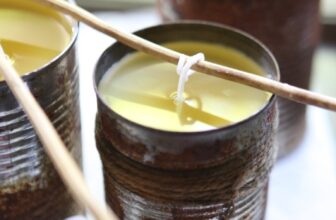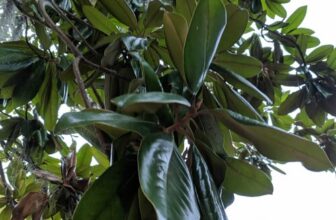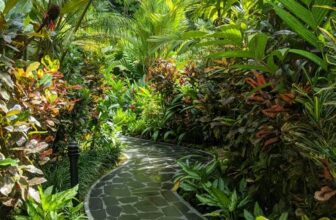Sometimes we all need easy planting tips for beginners.
If you’re short of time or worried you’ll ‘get it wrong’, then garden designer Jamie Butterworth, co-designer of the RHS Chelsea Dog Garden with Monty Don, shares straightforward ideas from his new book What Grows Together.

The main border in front of Jamie’s Form Plants is relaxed, stylish and colourful. The first step is to accept that even if you’re an experienced professional gardener, not all planting will work. It’s fine if plants die or don’t look happy – it’s part of creating a beautiful border.
Jamie wants to do for gardening what Jamie Oliver did for cooking with his ‘Five Ingredients’ recipe book, creating simple ‘recipes’ for beginners or ‘time-poor’ gardeners.
So What Grows Together is a book of plant combination ‘recipes’, featuring groups of between 2 and 7 plants.
‘I’ve worked with plants all my life,’ says Jamie. ‘And I’ve worked with some amazing garden designers and people who have been working with plants far longer than me. I’ve done show gardens for RHS Chelsea and RHS Hampton Court,’ he says, ‘as well as some lovely domestic gardens and everything in between.’
His Form Plants nursery also grows plants, especially plants for structure. So he really understands the way plants both look together and grow together.
I visited Jamie at Form Plants to find out how he approaches planting borders and what makes combinations work.

Jamie Butterworth at his nursery, Form Plants. He and his team built the offices themselves from recycled shipping containers. What Grows Together (affiliate link, see disclosure) went straight into the best-seller charts.
Tip #1 -The Planting Truth Nobody Talks About…
‘Plants die,’ he says. ‘Some plantings will work and some won’t. And we’ve got to be OK with that.’
Jamie compares gardening to cooking: sometimes it works, sometimes it doesn’t — although with gardening, ‘you may have to wait six months to see which it is.’
Tip for beginners: Don’t be afraid of failure. If a plant dies, then see it as an opportunity to plant something else.
‘And plants will always try to survive,’ says Jamie. They can be tougher than you think.

Many of the plants in the beautiful border in front of Jamie’s office were leftovers from projects such as the RHS Hampton Court show garden with Anya Lautenbach. ‘I might not have planted so much fennel if I hadn’t had so much fennel, but I think it works,’ he says. If a plant is easy to grow or easy to buy, then ‘go big’. Try it in large groups.
Sometimes plants die in a particularly hot dry summer or an unusually cold spell in winter. These plants can often be saved with minimum effort.
To find out what to do if plants are dying in the summer, see Dying Plants in Summer – Top Tips on How to Save Them.
And to remedy frost and cold damage, see How to Deal With Winter Damage to Shrubs.
Interestingly, the expert gardeners in both posts say ‘Don’t go out and cut back the dead foliage immediately!’ This really does count as an ‘easy tip for beginners’, because all you do is…nothing!
You may not like the look of a dying plant, but if you cut its foliage back during very hot or very cold weather, you will place it under more stress. It is less likely to recover.

Cornus kousa is one of Jamie’s favourite trees. ‘But it’s not doing well where we planted it,’ he says. ‘Summers have got hotter and this position may be too exposed.’
Easy Planting Tips for Beginners #2: Choose Plants That Like the Same Conditions
There’s a lot of information around which plant will go where, but Jamie suggests going back to basics and keeping it simple. ‘You don’t always have to think about North, South, East or West facing or pH levels,’ he says.
He says ‘just ask yourself: is this spot sunny or shady? Choose plants that tolerate those conditions.’
When putting plants together, they not only need to look good together, but they literally need to grow together. And they’ll grow best if they like the same conditions.

A shady corner of the RHS Dog Garden, designed by Monty Don and Jamie Butterfield. The easiest planting tip of all is ‘does this plant need sun or shade?’ Jamie says that most of the time you really don’t need to get more complicated than this.
To plant up the shady part of your garden, see Shade Gardening – How to Choose Perfect Shady Garden Plants.
If your problem is hotter summers and wetter winters, then see 10 Beautiful But Tough Perennials for Too Wet and Too Dry Summers.
And if you have a dry and sunny garden, then see How Do You Make A Dry Garden? and The Sand Garden – A Bold New Trend in Resilient Garden Design.
Easy Planting Tips for Beginners #3: Start with Structure
Jamie says he thinks of a border like a painting. ‘Except that you’re working in four dimensions. A painting is two dimensional, but in a garden you add the height. And then you add the fourth dimension – time. What will it be like in two, three or four months time?’
Top garden designer James Alexander Sinclair told Jamie one of the best easy planting tips for beginnners. He said that every border needs ‘form’ and ‘fluff’.
Form is the structure – the trees, topiary and shrubs. ‘That’s why I called my nursery ‘Form Plants,’ says Jamie.
The fluff is the flowers and the perennials.

Form and fluff. A row of sculptural tree ferns at Form Plants create structure and the billowing hydrangeas add ‘fluff’. Some may find it surprising that Jamie includes ornamental grasses as ‘form’ – because they offer distinctive shapes and long-term interest.
So begin with structure — trees, topiary, or shrubs. And Jamie also thinks of grasses as ‘structure’.
Then add “fluff” with perennials and annuals. Structure anchors the design year-round and gives perennials something to play against.
‘And I’d always include a multi-stem tree’ says Jamie.

Jamie thinks that multi stem trees offer the perfect structure. They leave room for planting underneath and their shape creates interest and definition. From his RHS Dog Garden at RHS Chelsea 2025.
To find some beautiful – and often over-looked – shrubs, see 8 Easy-Care Shrubs.
For the right tree, see Jamie’s advice here on The Best Trees for Small Gardens.
And for topiary, see The 3 Best Alternatives to Box for Simple Topiary.
To find out how grasses can add structure to your border, see 7 Brilliant Ornamental Grasses to Give Your Garden Light & Movement.
Easy Planting Tip #4: Keep It Simple
Jamie recommends using easy-to-grow plants, such as erigeron (Mexican fleabane/Seaside daisy). He says that garden designers can be snobby about plants that you can buy and grow almost anywhere. But put together in simple groups, they look stylish and are easy to maintain.
In the three planting recipes at the end of this post, one combines yew, Japanese Forest grass and Erigeron. This grouping will grow almost anywhere, it looks stylish and will need very little care.
When it comes to container planting, he particularly recommends ‘one type of plant per pot’ rather than trying to create combinations in a pot. ‘You can then group the pots.’
You can see more about this strategy in How to Group Pots with Dan Cooper.

One plant per pot – one of the best easy planting tips for beginners. Big pots may be expensive but they are easier to maintain than smaller ones because they allow for root growth and don’t dry out so quickly.
Easy Planting Tip #5: Try Ready-Made Recipes
Jamie’s book offers 60 planting recipes. Here he explains three recipes and why they work together.
Each combination is simple, effective, and designed to thrive.

Three easy border plant combinations from Jamie Butterworth. Top is nepeta, sesleria and rosemary. Centre is yew, erigeron and hakenochloa macra (Japanese forest grass). Bottom is agastache, miscanthus, Japanese anemone, Aster ‘Monch’ and Gaura.
1. Resilient and Timeless
-
Rosemary ‘Miss Jessopp’s Upright’ – evergreen, culinary, blue flowers
-
Catmint (Nepeta) – long-flowering – you can cut it back twice a year for three lots of flowers. Blue or lilac flowers, pollinator friendly and so easy to grow.
-
Sesleria autumnalis (Autumn moor grass) – lime-green foliage, great seedheads and will give you beautiful autumn colour. Grasses provide structure without taking up space.
Together, these give you silver, green and blue tones, year-round interest, and resilience in dry conditions.
2. Small-Space Sophistication
-
Yew (Taxus) – clipped into balls for structure. Jamie says that you can buy small plants cheaply and clip them into shape over time – but it will take a few years!
-
Hakonechloa (Japanese forest grass) – soft, tumbling texture and bright green leaves to contrast with the dark green yew.
-
Erigeron karvinskianus (Mexican fleabane/seaside daisy) – reliable, long-flowering groundcover which slefs
This mix balances form and softness, easy for containers or small borders.
3. Romantic Late-Season Border
-
Aster ‘Mönch’ – daisy-like flowers, strong late-summer colour
-
Japanese anemone ‘Andrea Atkinson’ or ‘Honorine Jobert’ – tall, elegant, long-lasting
-
Gaura (whirling butterflies) – airy movement. ‘I treat this almost as an annual,’ says Jamie. ‘It’s a short-lived perennial, but you’ll be lucky to get more than 2 years out of it.’
-
Agastache ‘Blue Fortune’ – bee magnet, long season of interest. ‘I’ve used agastache for RHS Chelsea in May, for RHS Hampton Court in July and now it’s still flowering in September,’ says Jamie.
-
Miscanthus – ornamental grass for structure and winter interest
This combination extends your border’s life into autumn, with height, texture and pollinator-friendly flowers. ‘It will all go a lovely chocolate-brown over autumn and winter. You’ll cut back the miscanthus in early spring, but if you add bulbs to the mix, you’ll have interest almost all the year round.
Easy Planting Tip #6 – Plant in Autumn (Fall)
Most of us think of spring as the beginning of the gardening year.
In fact, for professionals like Jamie, autumn (or fall) is the best time of year to plant trees, shrubs and many perennials. The soil is still reasonably warm and there is usually more rain. So roots start to grow and bed in before they go dormant in winter.
Then, when spring comes, they have a head start and are more likely to be able to cope with a drought in spring or summer.
This is one of the best easy planting tips for beginners, but it doesn’t mean you can’t plant at other times of year.
You can plant at any time, provided the ground isn’t frozen. But if you plant in a dry spring or during summer, you will have to pay attention to watering. That doesn’t necessarily mean drenching the plants with water every day or sprinkling them with a random spray. It means checking the soil near the roots regularly to see if it is dry. (see Garden Watering Strategies – How To Save Time, Money & Effort.)
See Jamie sharing his tips on video at his Form Plants office (the one he and the team made from recycled shipping containers!)
Pin to Remember Easy Planting Tips for Beginners
And do join us. See here for a free weekly email with more gardening tips, ideas and inspiration.






